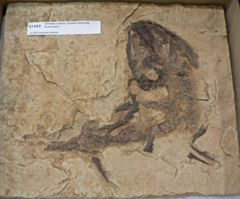Project 4547: R. R. Schoch. 2022. Phylogeny of the amphibamiform temnospondyls: the relationship of taxa known by adults, larvae and neotenes. Journal of Systematic Palaeontology. 20 (1):1-30.
Abstract
The Amphibamiformes, small temnospondyls from late Palaeozoic rocks, have been increasingly considered as the stem-group of some or all extant amphibians (Lissamphibia). Their relationships have become intensely studied after the discovery of new taxa and the revision of poorly known ones, but understanding is hampered by the fact that amphibamiforms fall into two very distinct groups: (a) terrestrial taxa known by adults only (Amphibamidae, Micropholidae) and (b) aquatic taxa known by larvae and neotenic adults (Branchiosauridae). The Branchiosauridae were recognized as a clade supported by a suite of larval synapomorphies, but the unknown larval morphology of the terrestrial clades leaves the question open to whether some branchiosaurid apomorphies might have been more widely distributed. Recently, some branchiosaurid specimens from Nýřany (Czech Republic) were proposed to be larvae of olsoniforms and amphibamids, and together with a revision of ancient branchiosaurid-like taxa from the United States and France prompt a re-analysis of this issue. In a phylogenetic analysis of 48 taxa and 113 characters, the Branchiosauridae were found to be monophyletic and nest in an unresolved trichotomy with Amphibamidae and the putative relatives of Lissamphibia. The present analysis finds the hypothesized olsoniform larvae from Nýřany to be adults of Branchiosaurus salamandroides, whereas some of the larvae from Mazon Creek (Illinois, USA) are not branchiosaurids, but immature specimens of the amphibamid Amphibamus grandiceps. Within branchiosaurids, four clades have been identified: (a) the Carboniferous Anthracobamus clade (Anthracobamus, Montceaubatrachus), (b) the mostly Carboniferous Branchiosaurinae (Branchiosaurus, Milnererpeton) and two largely Permian clades, the newly defined Apateoninae (genus Apateon) and Leptorophinae (Melanerpeton, Leptorophus, Schoenfelderpeton) clade. Branchiosaurid evolution involved a trend towards an enhanced paedomorphosis, a modification of branchial teeth, and successive reduction of bone in the scales and pectoral girdle.Read the article »
Article DOI: 10.1080/14772019.2022.2113831
Project DOI: 10.7934/P4547, http://dx.doi.org/10.7934/P4547
| This project contains |
|---|
Download Project SDD File |
Currently Viewing:
MorphoBank Project 4547
MorphoBank Project 4547
- Creation Date:
27 January 2023 - Publication Date:
27 January 2023
Authors' Institutions ![]()
- University of Hohenheim
- Staatliches Museum fur Naturkunde Stuttgart
Members
| member name | taxa |
specimens |
media |
| MorphoBank Curator Project Administrator | 1 | 1 | 1 |

